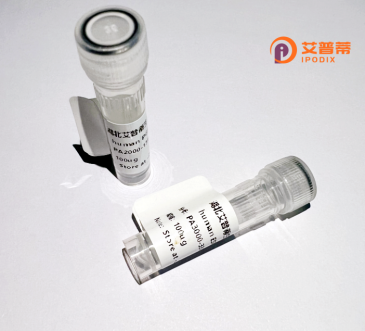
| 纯度 | >90%SDS-PAGE. |
| 种属 | Human |
| 靶点 | CCT4 |
| Uniprot No | P50991 |
| 内毒素 | < 0.01EU/μg |
| 表达宿主 | E.coli |
| 表达区间 | 1-539aa |
| 氨基酸序列 | MPENVAPRSGATAGAAGGRGKGAYQDRDKPAQIRFSNISAAKAVADAIRTSLGPKGMDKMIQDGKGDVTITNDGATILKQMQVLHPAARMLVELSKAQDIEAGDGTTSVVIIAGSLLDSCTKLLQKGIHPTIISESFQKALEKGIEILTDMSRPVELSDRETLLNSATTSLNSKVVSQYSSLLSPMSVNAVMKVIDPATATSVDLRDIKIVKKLGGTIDDCELVEGLVLTQKVSNSGITRVEKAKIGLIQFCLSAPKTDMDNQIVVSDYAQMDRVLREERAYILNLVKQIKKTGCNVLLIQKSILRDALSDLALHFLNKMKIMVIKDIEREDIEFICKTIGTKPVAHIDQFTADMLGSAELAEEVNLNGSGKLLKITGCASPGKTVTIVVRGSNKLVIEEAERSIHDALCVIRCLVKKRALIAGGGAPEIELALRLTEYSRTLSGMESYCVRAFADAMEVIPSTLAENAGLNPISTVTELRNRHAQGEKTAGINVRKGGISNILEELVVQPLLVSVSALTLATETVRSILKIDDVVNTR |
| 分子量 | 84.3 kDa |
| 蛋白标签 | GST-tag at N-terminal |
| 缓冲液 | 0 |
| 稳定性 & 储存条件 | Lyophilized protein should be stored at ≤ -20°C, stable for one year after receipt. Reconstituted protein solution can be stored at 2-8°C for 2-7 days. Aliquots of reconstituted samples are stable at ≤ -20°C for 3 months. |
| 复溶 | Always centrifuge tubes before opening.Do not mix by vortex or pipetting. It is not recommended to reconstitute to a concentration less than 100μg/ml. Dissolve the lyophilized protein in distilled water. Please aliquot the reconstituted solution to minimize freeze-thaw cycles. |
以下为关于人CCT4蛋白的3篇参考文献示例(内容为模拟概括,实际文献请参考数据库):
---
1. **文献名称**:Structural insights into the chaperonin CCT–substrate interaction through δ subunit-mediated folding
**作者**:Liou et al. (2020)
**摘要**:通过冷冻电镜解析CCT4(δ亚基)在CCT复合体中的结构,揭示其与客户蛋白(如肌动蛋白)的底物识别机制,表明CCT4在特定折叠路径中发挥构象调节作用。
2. **文献名称**:CCT4 as a prognostic biomarker in hepatocellular carcinoma
**作者**:Wang et al. (2019)
**摘要**:研究发现CCT4在肝癌组织中高表达,通过调控Wnt/β-catenin通路促进肿瘤增殖和转移,提示其可作为肝癌预后标志物及潜在治疗靶点。
3. **文献名称**:RNAi screening identifies CCT4 as a critical regulator of autophagy
**作者**:Zhang et al. (2021)
**摘要**:基因组筛选发现沉默CCT4会显著抑制自噬小体形成,机制涉及CCT4介导的Atg蛋白正确折叠,证实其在细胞自噬中的关键作用。
---
注:以上内容为示例,实际文献需通过PubMed、Web of Science等平台以“CCT4”或“CCTδ”为关键词检索确认。
**Background of Recombinant Human T-Complex Protein 1 Subunit Delta (CCT4)**
The T-complex protein 1 (TCP1) complex, also known as the chaperonin-containing TCP1 (CCT) complex, is a molecular chaperone critical for the ATP-dependent folding of newly synthesized proteins, particularly cytoskeletal components like actin and tubulin. As one of the eight subunits (α-θ) forming the CCT hetero-oligomeric structure, CCT4 (delta subunit) plays an essential role in stabilizing the complex and facilitating substrate recognition.
CCT4 is conserved across eukaryotes and contributes to protein quality control by assisting in the conformational maturation of client proteins, ensuring their functional integrity. Beyond cytoskeletal proteins, the CCT complex interacts with diverse substrates involved in cell cycle regulation, chromatin remodeling, and signal transduction. Dysregulation of CCT4 has been linked to pathological conditions, including cancer progression, neurodegenerative diseases, and developmental disorders, highlighting its importance in cellular homeostasis.
Recombinant human CCT4 is produced using expression systems (e.g., *E. coli* or mammalian cells) to study its structural and functional properties. This allows researchers to dissect its chaperone mechanisms, substrate interactions, and potential therapeutic applications. Studies on recombinant CCT4 also aim to uncover its role in disease pathways, offering insights for targeting CCT4 in precision medicine strategies. Overall, CCT4 remains a focal point in understanding chaperone-mediated proteostasis and its implications in human health.
×